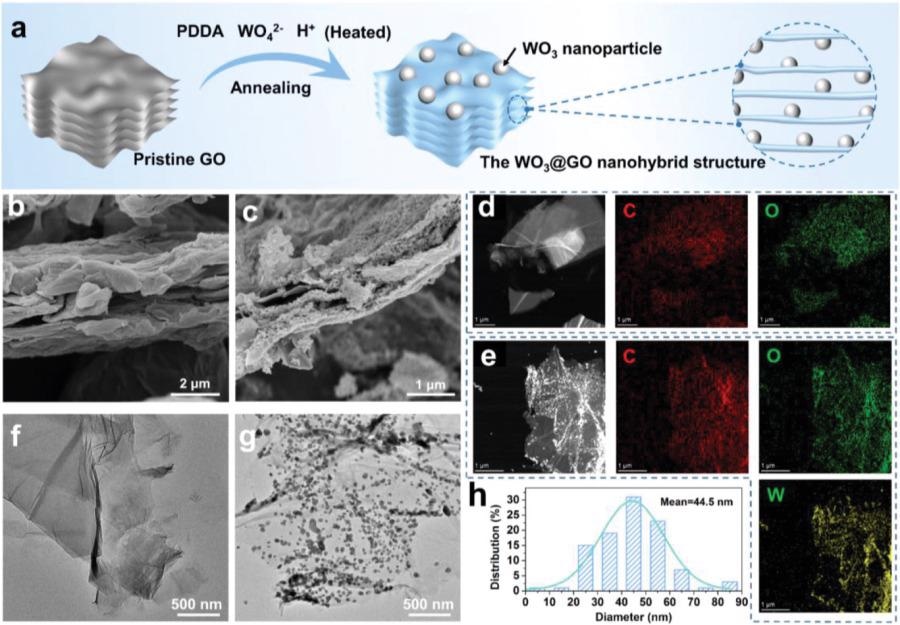The vanadium redox flow battery (VRFB) is a potential sustainable energy storage system. The ion-exchange membrane (IEM) used in a VRFB cell avoids a cathode or anode short circuit and prevents electrolyte crossover and side reactions. The membrane enables proton conduction to maintain the cell electrically neutral.
 The structure and morphology of WO3@GO nanohybrid. Image Credit: Shenzhen Institute of Advanced Technology.
The structure and morphology of WO3@GO nanohybrid. Image Credit: Shenzhen Institute of Advanced Technology.
The most extensively employed IEM for VRFBs until now is the perfluorinated sulfonic acid (PFSA) membrane. However, severe vanadium ion permeation of the PFSA membrane will reduce the cell’s life and cause the cell to perform unsatisfactorily.
A research group headed by Professor Huiyun Li, Professor Shuhui Yu, and Dr. Jiaye Ye from the Shenzhen Institute of Advanced Technology (SIAT) of the Chinese Academy of Sciences has designed a hybrid membrane depending on two-dimensional nanohybrid materials, which can enhance the VRFBs’ performance.
The study was reported in the Advanced Functional Materials on November 9th, 2021.
In the newly designed membrane, graphene oxide (GO) nanosheets were fitted in the PFSA matrix to serve as a “barrier” to decrease vanadium ion permeation. The tungsten trioxide (WO3) nanoparticles were in-situ grown on the surface of the GO nanosheets to beat the electrostatic effect and improve the dispersibility and hydrophilicity of the GO nanosheets.
These hydrophilic tungsten trioxide nanoparticles on GO nanosheet surfaces serve as proton active sites to facilitate proton transportation.
Dr. Jiaye Ye, Study First Author, Shenzhen Institute of Advanced Technology, Chinese Academy of Sciences
The porous polytetrafluoroethylene (PTFE) thin layer was wedged in the middle of the membrane as a strengthened layer improving membrane stability.
The hybrid membrane displayed high ion selectivity under the synergetic effect of WO3@GO and the PTFE layer. The VRFB single cell with the improved hybrid membrane offered energy efficiency and greater Coulombic efficiency than with that of the commercial Nafion membrane.
In their early study reported in the Chemical Engineering Journal, this research group came up with a sandwich structure composite membrane depending on one-dimensional functionalized silicon carbide nanowires.
The scientists initiated functionalized silicon carbide nanowires in a perfluorinated sulfonic acid (PFSA) matrix and fitted an ultrathin porous polytetrafluoroethylene layer. This hybrid membrane not just retains good proton conductivity but also efficiently decreases the penetration of vanadium ions. This helps enhance the VRFB cell’s performance.
Such studies offer a preparation strategy for developing high-performance IEMs for VRFBs depending on one-dimensional and two-dimensional modified materials. This can be expanded to other fields such as fuel cells and water treatment.
Journal Reference:
Ye, J., et al. (2021) In Situ Grown Tungsten Trioxide Nanoparticles on Graphene Oxide Nanosheet to Regulate Ion Selectivity of Membrane for High Performance Vanadium Redox Flow Battery. Advanced Functional Materials. doi.org/10.1002/adfm.202109427.